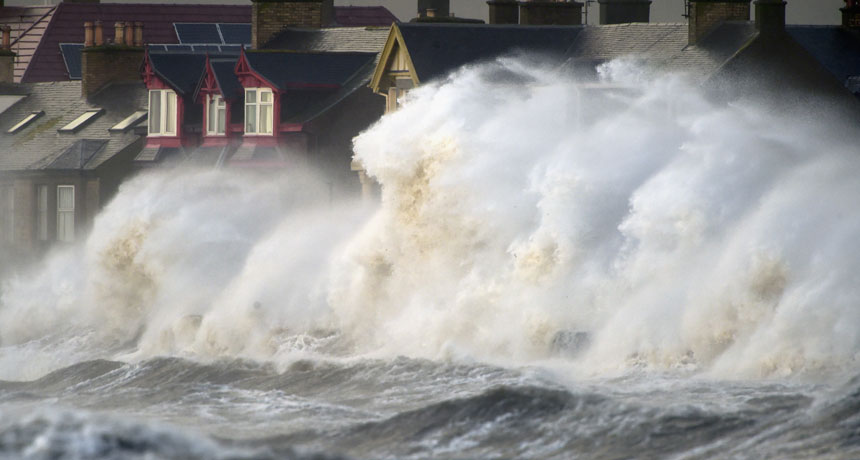Wave-thumping ‘weather bomb’ storms send elusive S waves through Earth

How the seafloor quivers under an intense storm called a “weather bomb” could help reveal Earth’s innermost secrets.
Using a network of seismic sensors, researchers in Japan detected a rare type of deep-Earth tremor originating from a rapidly strengthening cyclone over the North Atlantic Ocean. Tracking how these newfound shakes ripple through the globe will help geoscientists map the materials that make up the planet’s depths, the researchers report August 26 in Science.
“We’re potentially getting a suite of new seismic source locations that can be used to investigate the interior of the Earth,” says Peter Bromirski, a geophysical oceanographer at the Scripps Institution of Oceanography in La Jolla, Calif., who wrote a commentary on the new research in the same issue of Science. “Further investigations will refine our understanding of how useful these particular waves will be.”
Tremors traveling through the ground speed up, slow down or change direction depending on the type of material they pass through. Carefully measuring these movements from earthquake waves has allowed scientists to gather clues about the structure and composition of Earth’s deepest layers.
Some regions — the middle of tectonic plates under the ocean, for instance — don’t see many earthquakes, though. Luckily, weather bombs can generate their own seismicity. Whipping winds can stir up towering ocean swells. When two opposing ocean swells collide, the meet-up can send a pressure pulse down to the ocean floor. The pulse thumps the seafloor, producing seismic waves that penetrate deep into the planet.
Scientists had previously detected only one type —called P waves —of these storm-generated seismic waves. P waves cause a material to compress and stretch like an accordion in the same direction that the wave travels. The other variety, called S waves, has proved more elusive. S waves formed by storms are typically weaker than P waves and cause material to ripple perpendicular to the wave’s path. The effect is similar to when one end of a garden hose is jerked up and down, producing waves that travel along the hose’s length.
Seismologists Kiwamu Nishida of the University of Tokyo and Ryota Takagi of Tohoku University in Sendai, Japan, hunted for the elusive S waves using a network of 202 seismic stations in Japan. Typically, the waves are lost within Earth’s natural seismic background noise. By combining and analyzing the data collected by the extra-sensitive seismometers, however, the researchers were able to tease out the S wave signals.
The waves originated from a North Atlantic cyclone, the researchers found. That storm actually produced two types of S waves. SV waves shift material vertically relative to Earth’s surface and can form from P waves. SH waves shift material horizontally and their origins are more of a mystery. Those SH waves may form from complex interactions between the ocean and seafloor, Nishida says.
Combining measurements of P, SV and SH waves will “ultimately provide better maps of Earth’s mantle and maybe even the core,” says Keith Koper, a seismologist at the University of Utah in Salt Lake City. Koper and colleagues report similar observations of S waves generated in the Pacific Ocean and detected by a Chinese seismic network in the Sept. 1 Earth and Planetary Sciences Letters. “It’s nice to see someone else get similar results —it makes me feel more confident about what we observed,” Koper says.